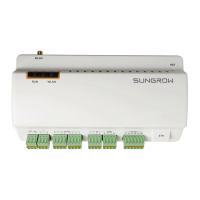85
Step 3 Set local dispatching parameters. For specific parameter description, refer to the following
table.
table 8-8 Parameter description
Parameter
Description
Control method
Open-loop control: At the start time, the locally configured
active instruction is sent to the power output port of the inverter,
thereby implementing reactive power control.
Closed-loop control: At the beginning time, reactive instruc-
tion configured locally is used as target value, reactive power
and power factor of the meter need to be collected and used as
input parameters, and reactive power compensation ratio is cal-
culated and sent to power output port of the inverter. Generally,
this strategy is used for improving the power factor of the prop-
erty boundary point.
Select energy meter /
transformer*
Select Smart Energy Meter involved in power regulation
Power Limit in Case of
Meter Communication
Anomaly (%)
In the event of meter communication failure, set a fixed propor-
tion to limit the power fed into the grid.
Wiring mode*
Direct connection: One Logger1000 is connected to all inver-
ters, where all the inverters must be string inverters or central
inverters.
Cascading: Multiple Logger1000 are cascaded, and this Log-
ger1000 is used as the host.
Line reactive power
compensation*
Compensation for reactive power losses in the line
Control cycle
Time interval of delivering dispatching instructions
Parameter range: 5~60s
Instruction Type
PF: set the power factor as the target value
%: set reactive power percentage.
Note: *Only when the control method is set to Closed-loop control, the parameter Select
energy meter / transformer is settable. When selecting an energy meter, the Logger used
must be the one manufactured by SUNGROW.
Step 4 Add local power control manner
Fill in Start time and Percentage(PF), and click Save.
- - End
Subsequent Operation
Delete local power control manner: select a local power control manner that needs to be de-
leted, and click Clear data.
User Manual 8 Grid Dispatching Function

